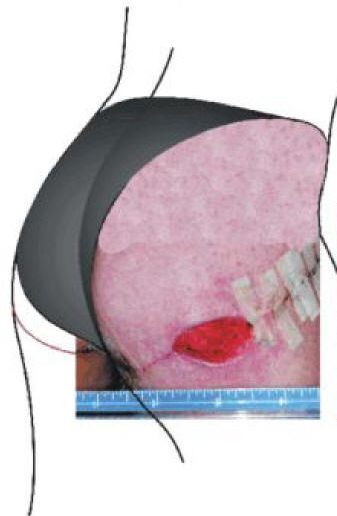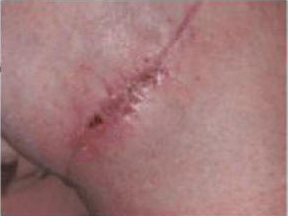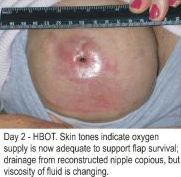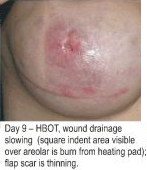Hyperbaric Oxygen Therapy (HBOT) is routinely used in more than 700 centers in the United States for wound healing. Many plastic and reconstructive practices now have their own HBOT chambers. These surgeons routinely treat their patients before and after cosmetic surgery, tailoring the HBOT into their overall surgical plan for the patient.
There are times when a patient has unexpected and negative complications after surgery or when results are less than hoped for. HBOT is the rapid recovery tool that will accelerate your return into your regular lifestyle, quickly getting rid of post-operative swelling and bruising. Scroll down to read of three patients who needed to resume their lives quickly!
Hospital-based hyperbaric medicine departments usually will not accept patients unless they are in a life or limb threatening crisis. As well, hospital HBOT departments charge patients more than $1,800.00 per 90 minute treatment in their chambers. Few patients can afford this. Private centers provide hospital standard care at a fraction of the price. Our clinic’s chambers do not use masks or hoods that would impede the healing of elective facial surgery. The zero gravity chair is ideal for patients who have had tummy-tucks or liposuction.
Discuss HBOT with your plastic surgeon if you have a need to accelerate healing, eliminate post-operative bruising and swelling to return to your regular activities quickly.
If your surgeon decides that HBOT is appropriate for you, it is probable that you will qualify for a payment plan.
The most often used HBOT protocol for elective surgery patients is the “Potkin Protocol” pioneered by Dr. Ralph Potkin of Malibu Hyperbaric Medical Center.
“I am always delighted to see the rapid recovery of surgical patients after I refer them for HBOT sessions. Inflammation, edema and bruising subside in just days, rather than weeek post-surgery.
“Clearly the HBOT, when used as an adjunct to antibiotics, is a superior way to speed recovery. I believe that HBOT will one day be the mainstay of anti-aging protocols.
“I personally use HBOT for its rejuvenating effects. Because of my hectic work schedule, I used hyperbaric oxygen therapy for five days after my laser resurfacing. Healing was so fast, I was able to return to my patients in just eight days later. From experience, I believe that my healing was accelerated by at least 60%.”
Ms. Glossip’s nursing specialty is the care of elective surgery patients.
Buttock Lift Salvage
Patient “CW”, age 44, buttock sculpting. The challenge facing the surgeon was the patient’s natural red hair and fragile sun-damaged fair skin challenged by the dynamic body movements of walking and sitting tensioning the wound.
Two other factors impacted the outcome. Firstly, each surgical scar was in excess of eighteen inches and under tension. Next, the area of skin removed had underlying fat cells rather than muscle tissue which provides better scaffolding support for suturing the fascia.
Three days after suture removal, a wound, measuring 8.2 x 6.5 cm (3.5″ x 2.5″) and 2.6 cm deep opened on the right thigh. The patient was given three 90 minutes HBOT sessions at 2.5 ata (21 psig) to strengthen wound edges.
These were successfully resutured with only minor follow-up attention required by the wound care nurse. Another four HBOT sessions followed and the wounds closed normally.
Wounds respond dynamically to increased oxygen tension.
Breast Prosthesis Salvage
Two years earlier, the patient underwent a radical mastectomy of her left breast. To maintain patient symmetry and proportion, the surgeon used a prosthetic implant to match the size and shape of her unaffected breast.
Cancer was later discovered in this right breast and again, the surgeon chose to reconstruct to the “DD” size rather than subject the patient to double breast reduction.
The challenge for the surgeon was the weight of the prosthesis to be supported by the complicated feminine architecture. Six weeks after the radical mastectomy, the nipple was reconstructed.
Two weeks later, the surgeon added HBOT to the antibiotic therapy already underway using Dicloxacillin.
The breast quickly regained normal skin tones. However, drainage continued for 15 days. The patient received a total of 32 X :90 minute sessions of HBOT at 21.4 psi (48 feet of sea water) at the clinic.
Patient’s comments:
“I am now 18 months post surgery. The scars of surgery are now invisible and I look so normal, you would have to be told that I had such radical surgery. My optimism and good cheer has returned and I think of myself as cured of cancer, rather than a ‘survivor’. I am delighted with the surgical artistry of Doctor Vecchione and the care of his staff.”
Physician’s comments:
“High dosage oxygen – HBOT – is a very effective therapy tool for reducing inflammation and edema. Healing proceeds with good circulation, oxygen availability, and a reduction in congestive tissue back-pressure of ‘edema’.
“Regrettably, HBOT is an underutilized resource since physicians have not been apprised of its benefits, and cost effectiveness. Likewise its therapeutic efficacy remains understated.
“HBOT is now available at a fraction of the cost of hospital based HBOT departments that are designed for critical life-saving support teams.” Harvey Tuomi, M.D.











